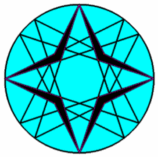QG-1: Systematics for describing QG-Points
A Quadrigon is also called a Tetragon. It is called a Quadrigon because of the relationship with a Quadrangle and a Quadrilateral.
In the descriptions of EQF these are the definitions of these terms:
- A Quadrangle is a system of 4 random points without conditions. It also often is called a Complete Quadrangle.
- A Quadrilateral is a system of 4 random lines without conditions. It also often is called a Complete Quadrilateral.
- A Quadrigon is a system of 4 consecutive points and 4 consecutive connecting lines. It is also called a Tetragon. There is a cyclic order of points and lines, meaning here that the permutation of 4 points in a certain order equalizes the permutation of 4 points in the reversed order. When the order in a permutation of a cycle equalizes the permutation with reversed order we will name this condition “vv-cyclic” (“vv” stands for “vice versa”).
Within a Quadrangle (4 random points) 3 combinations can be discerned of 4 vv-cyclic consecutive points.
Within a Quadrilateral (4 random lines) 3 combinations can be discerned of 4 vv-cyclic consecutive lines.
Knowing a Quadrigon it can belong to a Quadrangle as well as to a Quadrilateral.
It can be seen as the “intersection“ of a Quadrangle and a Quadrilateral.
A Quadrigon occurs where Quadrangle and Quadrilateral meet.
Because in a Quadrigon lines as well as points play a role the algebraic description of a Quadrigon can be done with QA-coordinates (see QA-1) as well as with QL-coordinates (see QL-1). The only disadvantage in both cases is that the 3 coordinates of a QG-point will not be cyclic. However when we observe the coordinates of 3 QG-points in the 3 Quadrigons implied by the combinations within a Quadrangle/Quadrilateral they can be seen as “tricyclic symmetric points”, meaning that the components of their coordinates rotate as well as are cyclically re-ordered.
There is also another way of algebraic description in a Quadrigon.
I found that a simple Cartesian coordinate system with projective coordinates (i.e. a normal x- and y-coordinate combined with a z-coordinate for indicating infinity points) also gives symmetric results in the x- and y-coordinate.
This is not surprising because a Cartesian coordinate system has 4 quadrants in each of which we can pin a vertex even so that the diagonals concur with the origin.
Estimated human page views: 2427
